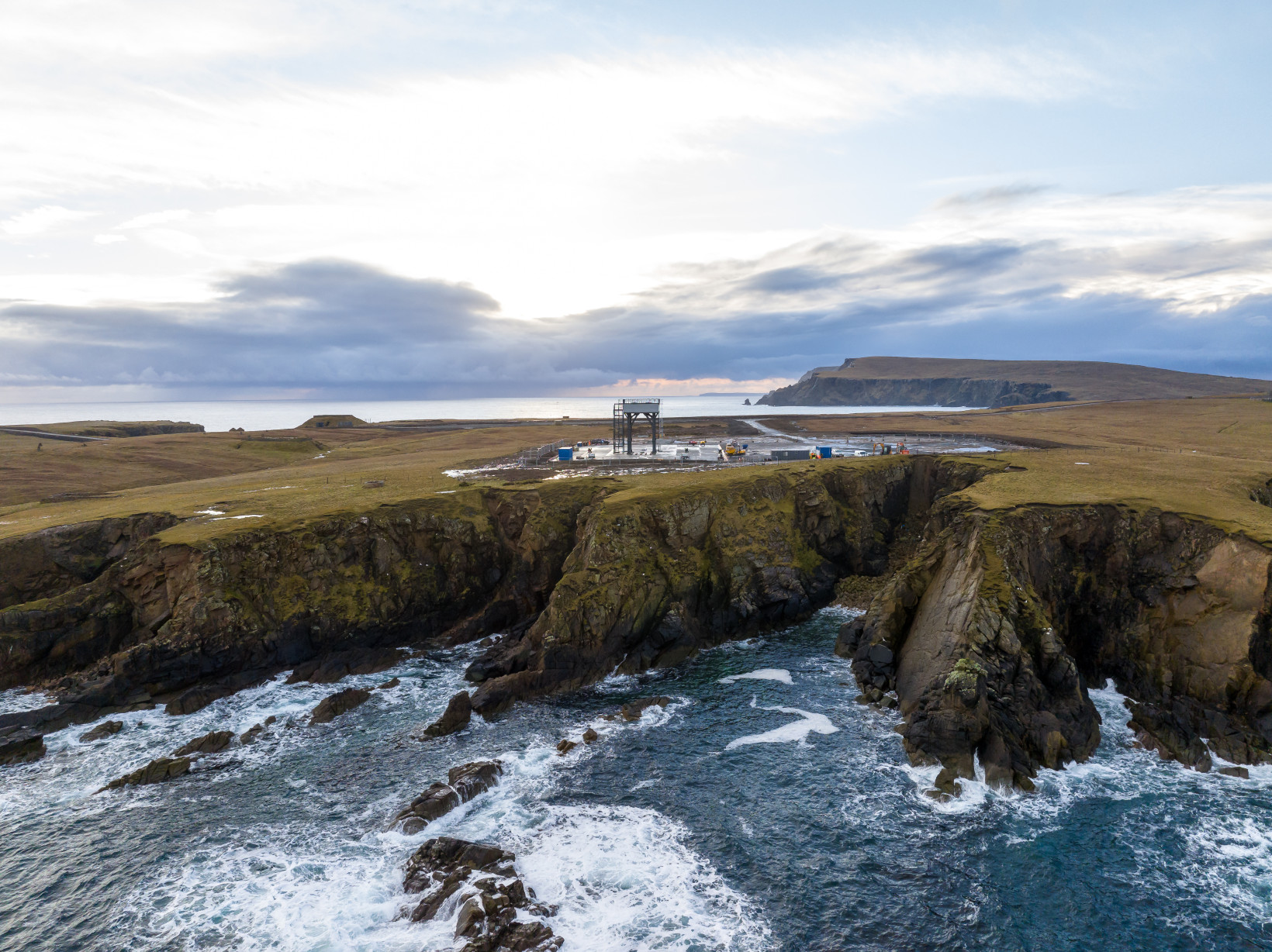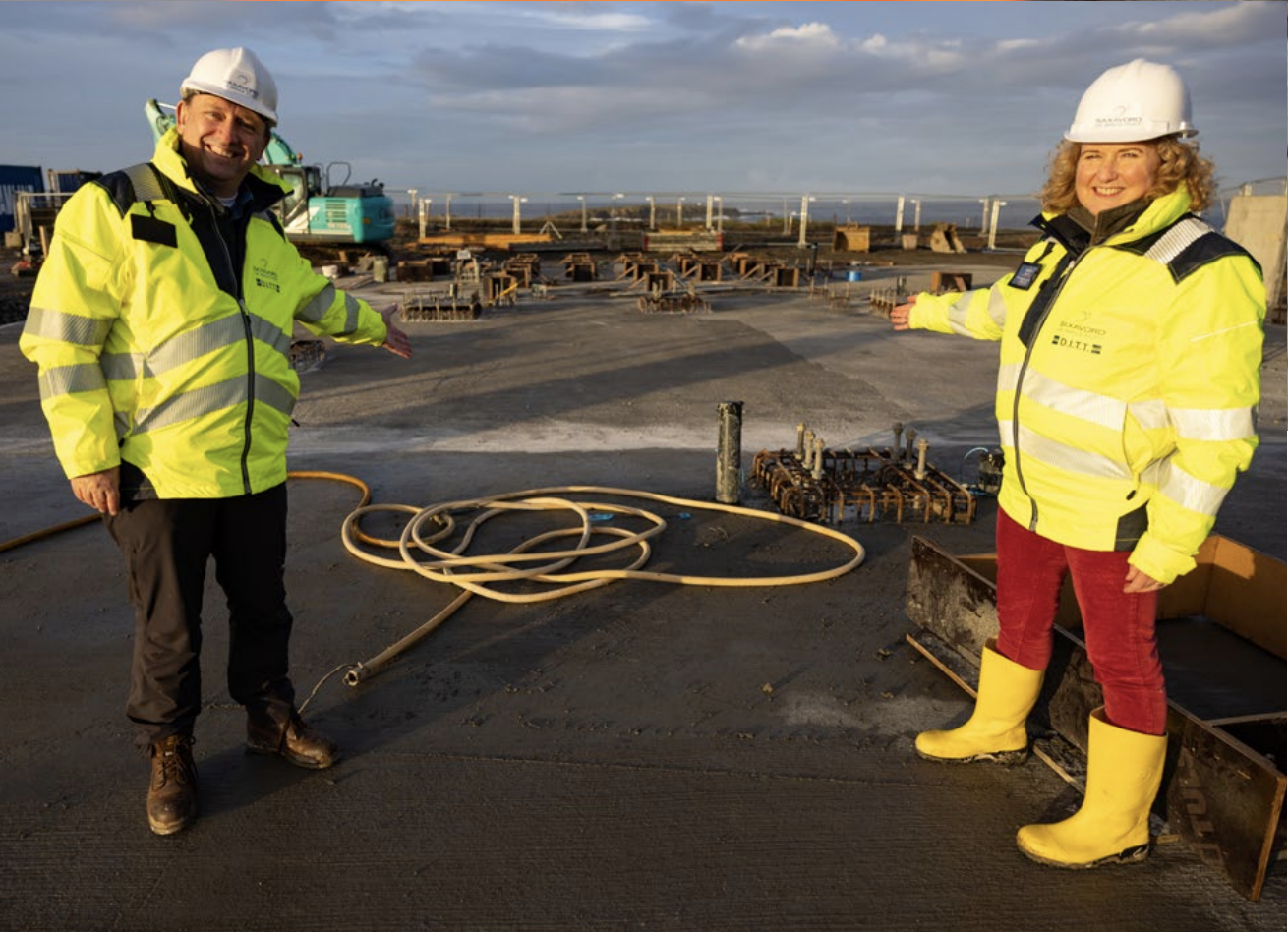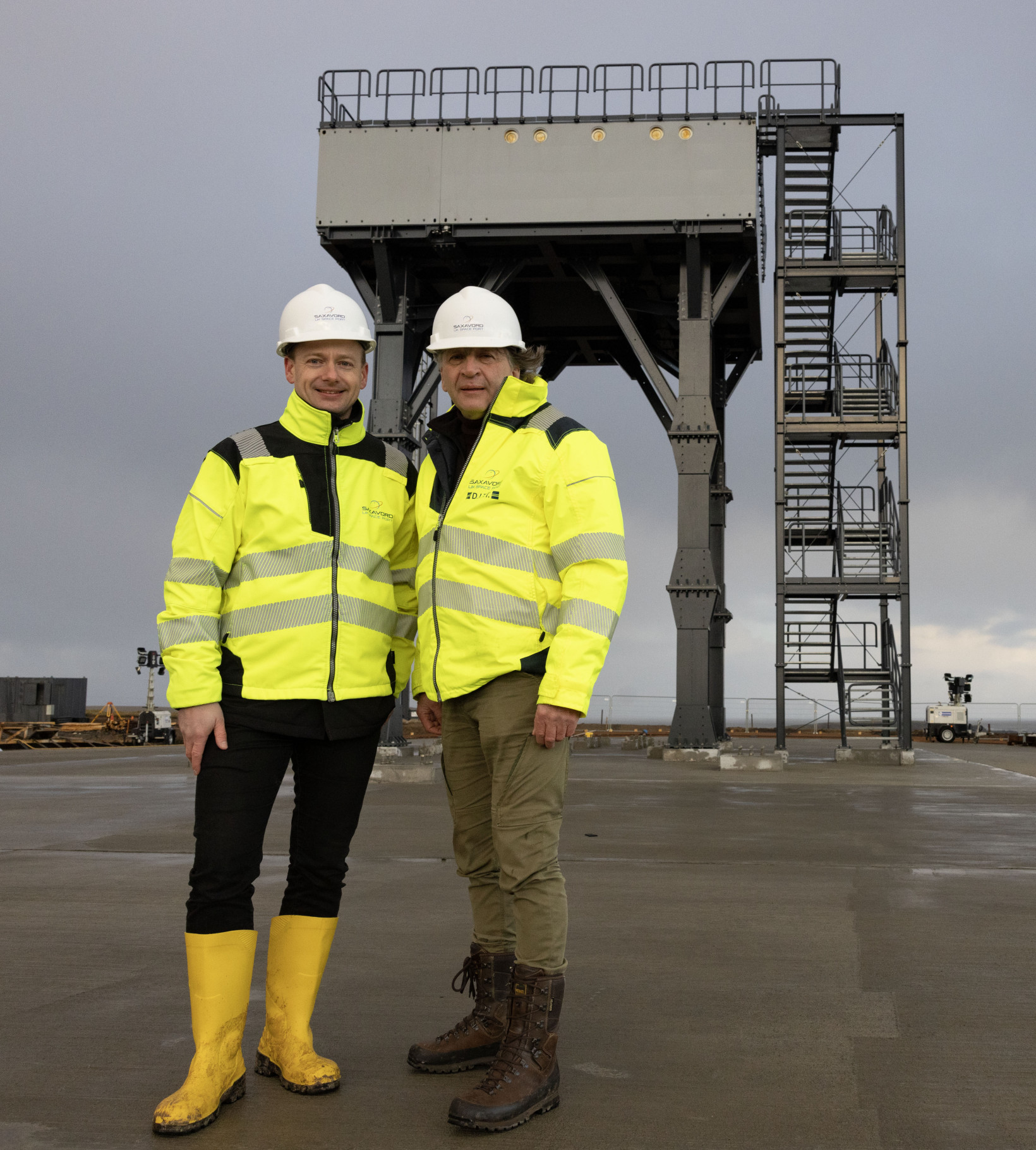How to build a spaceport
11 min read
[ad_1]
Around 250 kilometres off the north coast of Scotland, the Shetland isle of Unst undergoing a dramatic renovation.
On a peninsula flanked by giant cliffs and open ocean, builders are constructing a spaceport. They call the project SaxaVord. They say it could host the first-ever vertical rocket launches from Western Europe.
It’s a bold objective that welcomes auspicious signs. One was discovered just this summer; another was already known when the team laid their founding stone.
Over 1,000 years ago, the locals say, Unst became the first footfall of the Vikings in the North Atlantic. Staff at SaxaVord would joke that they were exchanging longships for spaceships. They hoped to inherit the Norse spirit of exploration.
“It’s going from the Bronze Age to the Space Age.
The second harbinger revealed an even older heritage. While excavating the site, workers unearthed an ancient burial ground. The discovery suggests the site has over 4,000 years of human activity — three millennia longer than the Viking heritage. SaxaVord sensed another good omen — and a cute new slogan.
“It’s going from the Bronze Age to the Space Age. That’s how we see it,” Scott Hammond, the spaceport’s operations director and deputy CEO, tells TNW. “We also think there’s a stone circle, which would have been aligned with the stars. It just goes to show, doesn’t it? If it was a good location in the Bronze Age, it’s a good location now.”
It’s a good location for several reasons — but more on that later. It’s also a location with a powerful pull for Europe’s burgeoning spacetech sector.


Declining costs, rapid innovation, and growing commercialisation are democratising access to space. In 2022, an estimated 6,905 active satellites were orbiting Earth — 2,105 more than in the previous year.
Back on our home planet, the demand for rocket launch sites is rising. Dr Christoph Baumeister, who scouts spacectech investments for VC firm Possible Ventures, says the sector is searching for new locations for lift-offs.
“They definitely are looking for options because you don’t want to be dependent on one country or one company,” he says. “If you look at the spaceports that we have at the moment, they will not be enough to cater for the launches that are projected to happen and that are being planned.”
The surge in launches will also bring benefits down to Earth. From GPS and weather forecasting to solar cells and medical treatments, space delivers countless real-world benefits. As the number of spaceports increases, the breakthroughs could proliferate.
Hammond envisions SaxaVord at the forefront of the innovations. He compares the spaceport’s potential to the canals and railways built during the Industrial Revolution. Once that infrastructure was in place, a boom period began for scientific, technological, and economic development.
“That’s effectively what we are: an infrastructure,” he says. “We will be an enabler for everything else.”
At least, that’s the plan. But building a spaceport isn’t your average construction project. At SaxaVord, the plan comprised a unique series of steps.
1. Find a location
Western Europe has a dearth of suitable sites for spaceports. At present, the region’s only orbital launch complex is the Guiana Space Centre in, err, South America. On the mainland, a combination of densely populated nations, heavy air traffic, and limited easterly expanses of water have left few favourable locations for rocket launches.
Unst is a rare exception. The 120 km2 island is remotely located, surrounded by ocean, and home to only 600 people. It also has a low volume of both sea and air traffic.
In the north of Unst, satellite launchers can get a clear, unobstructed route into orbit. In addition, the isle already had decent transport links, which were built for the nearby North Sea oil and gas fields.
The SaxaVord team is also confident about the weather conditions. They estimate that 95% of days from spring to autumn will have three hours of suitable winds. During winter, that will drop to around one day in three.


The British government shares SaxaVord’s optimism. In 2017, the UK Space Agency identified the location as its preferred site for satellite launches.
“The site offering the maximum payload mass to orbit is SaxaVord in the Shetlands, from where direct launch is possible to both SSO [sun-synchronous orbits] and polar orbits,” the report reads.
It’s a compelling package for a spaceport. But Unst’s natural attractions also created problems.
2. Study your environment
The location and environment of the Shetland Islands make the peninsula a wildlife haven. The archipelago is home to nearly a million seabirds — the largest colony of its kind on this side of the Atlantic.
As the northernmost point of the British Isles and home of the Hermaness nature reserve, Unst has a particularly powerful appeal to migrating birds. A new spaceport could threaten their habitat.
It’s a repercussion that’s caused controversy for Elon Musk’s SpaceX. The company’s rocket launches in Texas were blamed for the decline of an endangered bird species, which threatened plans to expand the spaceport.
SaxaVord is obligated to mitigate such risks. To launch rockets into space, every British operator must be licensed by the Civil Aviation Authority (CAA). Part of the licence application is an environmental assessment.
“We are the most real of all the UK’s spaceports.
In SaxaVord’s application, the spaceport proposed a maximum of 30 launches per year, some of which would occur during the bird breeding season.
RSPB Scotland, a conservation charity, had initially opposed the plans. But the organisation withdrew its objection when SaxaVord pledged to avoid launches between mid-May and the end of June — a key period for bird mating.
As part of the assessments, the spaceport took two years of bird counts on the land. The results not only guided the project, but also shone new light on another threat to avians: bird flu.
“Over on Hermanes, puffins are down by 90%,” says Hammond.


Unst’s environmental protections extend to human habitations. On the land of the spaceport lies a historical monument site — an old radar base for Britain’s Royal Air Force (RAF) during the Second World War.
It’s a landmark that was pivotal to the spaceport’s origins. SaxaVord is the brainchild of Frank and Debbie Strang, a married couple who met while serving at the RAF. After discovering the old military site was for sale, the couple bought the land with plans to develop an ecotourism business.
In 2008, they made a dramatic change of direction. When the UK Space Agency nominated Unst for a spaceport, the Strangs decided to bring the vision to reality. But their origin story had a troublesome subplot.
Conservationists were concerned about SaxAvord’s threat to the monument. In 2021, an environmental agency made a potentially fatal intervention.
Historic Environment Scotland said the spaceport would have an “extensive and adverse impact on the cultural significance” of the radar station. The organisation rejected the construction application. But after a year of negotiations and reassurances from SaxaVord, the objection was withdrawn.
As the regulatory barriers lifted, the development moved forward.
3. Design your spaceport
A spaceport is a uniquely challenging design project — particularly in a country that’s never had one before.
As the UK had no specific guidance for rocket launches, Hammond sought direction from US regulations.
“They come under something called CFR 420, which specifies how you need to approach the design of a spaceport,” he says. “And the first focus is always safety.”
Upon review of the rules, SaxaVord fine-tuned its safety guidelines. Among the final requirements were specific distances from populated areas, proximities to roads, and circumventions of flight paths or busy seas.
“It’s providing a one-stop shop for space.
On the site, the guidance steered the positioning of launch pads, rockets, fuel load, and hangars. The pads, for instance, needed a certain space between them to avoid any explosions spreading fires across the spaceport. A similar concern guided the rocket hanger locations.
“I want my hangars to be as close as possible because bringing a rocket in and out takes time and there’s risk involved with that process,” Hammond says. “But equally, I don’t want it so close that an explosion on the pad would destroy my hangar.”


Another crucial part of the plan is the launch schedule.
SaxaVord has applied for up to 30 vertical rocket launches a year. To squeeze in all those lift-offs, the spaceport will operate like a commercial airport. Launches will be scheduled across regular timeslots, with a busier timetable during the summer, when travel conditions are more favourable.
It’s a model that’s attractive to the satellite companies. According to spacetech investor Baumeister, startups want to show clients that they have multiple takeoff options.
“It’s about the speed that they can offer customers,” he says. “If they can have possibilities to launch in Northern America, in Europe, and in Asia… they’re well positioned.”
Once the plans were finalised, the construction could commence.
4. Start building
SaxaVord elected to build three launch pads, each of which is linked to a set of hangars. The pads will fire rockets of up to 30 metres in length, with maximum payloads of 1,500 kg. They will then fly into sun-synchronous, polar and high-inclination orbits, as well as suborbital trajectories.
To make that happen, SaxaVord has set up facilities for satellite monitoring, fuel storage, launch vehicle preparation, and payload processing. Connectivity will be provided by a ground station network of 1.5m to 3.7m antennas.
All of that requires extensive support infrastructure. To protect the spaceport, security fences have been erected around the perimeter. Access to the site is being improved by extensive upgrades to approach roads, which need to accommodate lorries carrying rockets from the mainland. SaxaVord has also leased an airfield close to the site.
To monitor the launches, on-site tracking and telemetry systems have been installed. The project is also getting flight termination systems — in a case a rocket soars in the wrong direction and disappears.
Another requirement is accommodation for both staff and visitors. A new hotel with around 250 beds and a visitor centre is under development, which aims to attract both birdwatchers and rocket fans. The accommodation also provides a supplementary income stream — a vital need for SaxaVord.
5. Keep the funding coming
Spaceports are not your typical investment. Business plans are offbeat, customer bases are nascent, and returns are uncertain.
Launches are also fraught with risk, as Spaceport Cornwall recently showed. In January, the British site attempted the first orbital launch from Western Europe — but the Virgin Orbit flight failed dramatically. Just months later, Virgin Orbit filed for bankruptcy.
In addition to these challenges, SaxaVord has to overcome another barrier. Unlike most spaceports, the project has received little public funding. Instead, the site largely relies on private investments.
“We could hit the moon from here,”
Hammond points to the model’s benefits. He’s wary of business plans that depend on public investment and time-consuming grant processes. But he acknowledged that SaxaVord’s funding model had initially attracted scepticism.
“Because the whole industry is used to being government-led, people would say that if the government’s not giving you any money then you’re not real,” he says.
“We had to get over that. And now, we are the most real of all the spaceports — because it’s private money. Because if we’re spending our own money, we’re a damn sight more careful about our decisions.”
In May, SaxaVord CEO Frank Strang told a parliamentary committee that his company had spent nearly £30mn (€34.6mn) on the spaceport. He added that the project had recently secured a £139mn (€160mn) debt facility.
Three months later, the BBC reported that the project had secured £20mn (€23mn) in equity, £10mn (€11.5mn) in debt and loans, along with a large development bond.
Launch operators provide one income source. Germany’s Rocket Factory Augsburg (RFA), which has secured exclusive access to one launch pad, said the deal included a “double-digit million-pound investment” in SaxaVord.


Private investors have made another vital contribution. They include Anders Holch Povlsen, a Danish billionaire and the largest landowner in northern Scotland. Povlsen had previously raised an environmental objection to another spaceport planned for near his land in Sutherland.
Supplementary income streams add another cash injection. As well as the launch service, there’s the aforementioned hotel, plus support and data services.
“It’s providing something of a one-stop shop; they just come to us and they get everything when they arrive,” Hammond says.
6. Start the countdown
A final piece in the SaxaVord jigsaw is the spaceport licensing. According to Hammond, the project is currently at the final stages of the application process, which involves an array of time-consuming details.
“It’s like when you buy a house,” he says. “That last bit takes bloody forever, and there are lots of little things that come out of the woodwork.”
The next step will be getting those rockets in the sky. Alongside RFA, SaxaVord has attracted launch partners including American aerospace giant Lockheed Martin, Edinburgh-based rocket firm Skyrora, and HyImpulse, a spinoff from the German Aerospace Centre.
Some could even fly before the spaceport license arrives. British aviation regulators will permit suborbital launches within an altitude of 50 km and using engines below a set size.
On this basis, HyImpulse has gained permission for the maiden voyage of its SR75 rocket. The launch can take place between December 1, 2023 and November 30, 2024, European Spaceflight reports.
SaxaVord hopes to make it happen before the end of the year. The first orbital launch, meanwhile, has been earmarked for next summer. If all goes to plan, the spaceport will host four to five launches next year, across both orbital and suborbital trajectories.
Despite the progress, there are obstacles ahead. There are still facilities to build and a license to obtain. Some tests, such as flight tracking trials, can only be passed when satellites are launched into space. Only then will the spaceport have accomplished its initial mission. Nonetheless, Hammond is already dreaming of the stars.
“We could hit the moon from our location,” he says. “But we are really an enabler for everything else.”
Around his office on Unst, the development is progressing as we speak. Hammond still has revolution on his mind.
“We had the Industrial Revolution and the digital revolution — this could be a revolution of access to space.”
[ad_2]
Source link




